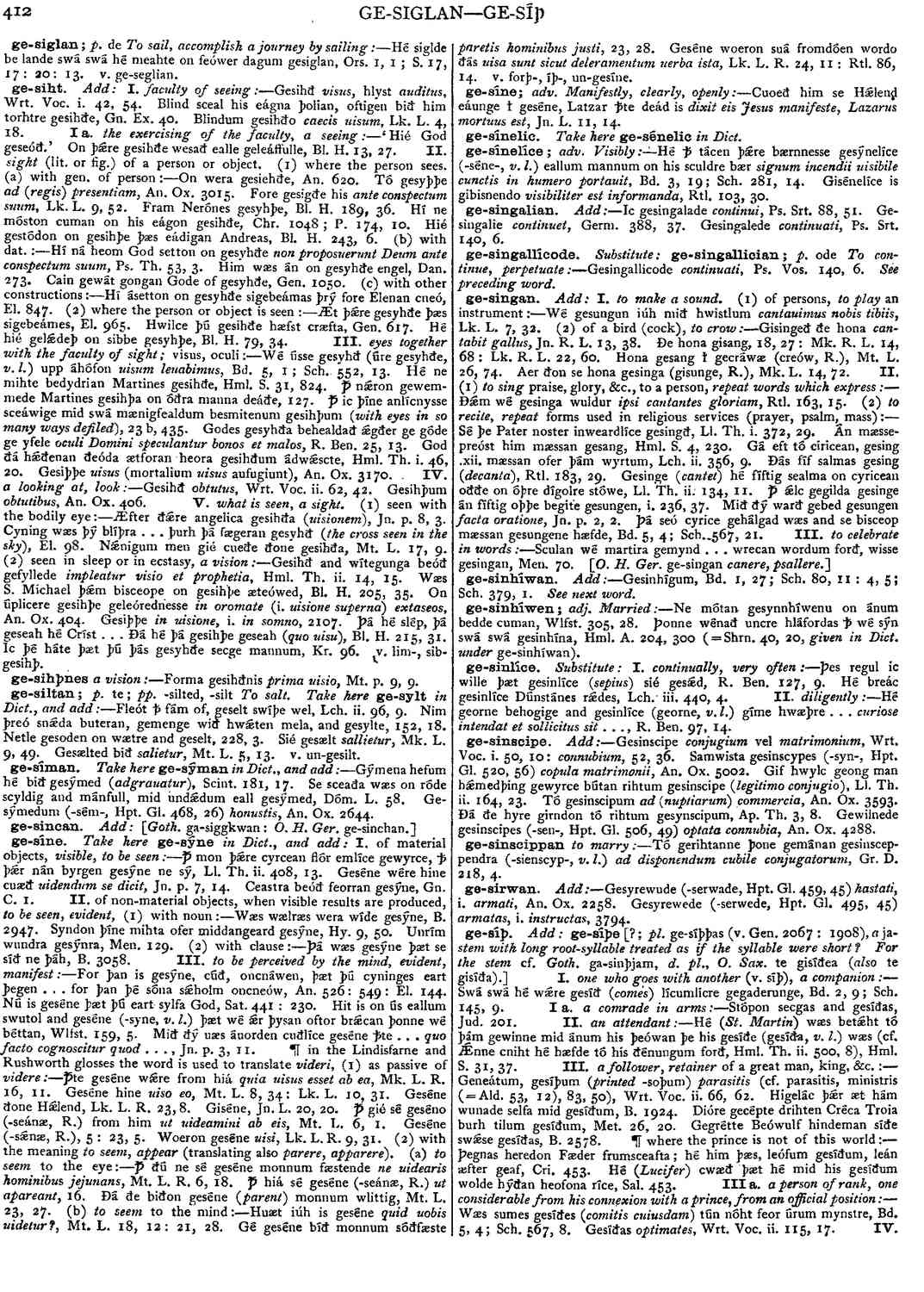ge-síne
-
Þ mon þǽre cyrcean flór emlíce gewyrce, ꝥ þǽr nán byrgen gesýne ne sý,
- Ll. Th. ii. 408, 13.
-
Geséne wére hine cuæð
uidendum se dicit,
- Jn. p. 7, 14.
- Ceastra beóð feorran gesýne, Gn. C. I.
-
Wæs wælræs wera wíde gesýne,
- B. 2947.
-
Syndon þíne mihta ofer middangeard gesýne,
- Hy. 9, 50.
-
Unrím wundra gesýnra,
- Men. 129.
-
Þá wæs gesýne þæt se síð ne þáh,
- B. 3058.
-
For þan is gesýne, cúð, oncnáwen, þæt þú cyninges eart þegen . . . for þan þé sóna sǽholm oncneów,
- An. 526: 549: El. 144.
-
Nú is geséne þæt þú eart sylfa God,
- Sae. 441 : 230.
-
Hit is on ús eallum swutol and geséne (-syne,
v.l.)
þæt wé ǽr þysan oftor brǽcan þonne wé béttan,- Wlfst. 159, 5.
-
Mið ðý uæs áuorden cuðlíce geséne ꝥte . . .
quo facto cognoscitur quod
. . . ,- Jn. p. 3, 11.
- ¶ in the Lindisfarne and Rushworth glosses the word is used to translate videri,
-
Þ te geséne wǽre from hiá
quia uisus esset ab ea,
- Mk. L. R. 16, 11.
-
Geséne hine
uiso eo,
- Mt. L. 8, 34: Lk. L. 10, 31.
-
Geséne ðone Hǽlend,
- Lk. L. R. 23, 8.
-
Giséne,
- Jn. L. 20, 20.
-
Þ gié sé geséno (-seánæ, R.) from him
ut uideamini ab eis,
- Mt. L. 6, Geséne (-sǽnæ, R.), 5 : 23, 5.
-
Woeron geséne
uisi,
- Lk. L. R. 9, 31.
-
Þ ðú ne sé geséne monnum fæstende
ne uidearis hominibus jejunans,
- Mt. L. R. 6, 18.
-
Þ hiá sé geséne (-seánæ, R.)
ut apareant,
16. -
Ðá ðe biðon geséne
(parent)
monnum wlittig,- Mt. L. 23, 27.
-
Huæt iúh is geséne
quid uobis uidetur ?,
- Mt. L. 18, 12: 21, 28.
-
Ge geséne bíð monnum sóðfæste
paretis hominibus justi,
- 23, 28.
-
Geséne woeron suá fromdóen wordo ðás
uisa sunt sicut deleramentum uerba ista,
- Lk. L. R. 24, 11 : Rtl. 86, 14.
- v. forþ-gesíne, íþ-gesíne, un-gesíne.
Bosworth, Joseph. “ge-síne.” In An Anglo-Saxon Dictionary Online, edited by Thomas Northcote Toller, Christ Sean, and Ondřej Tichy. Prague: Faculty of Arts, Charles University, 2014. https://bosworthtoller.com/49678.
Checked: 0